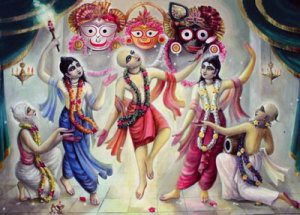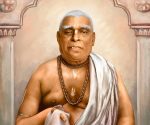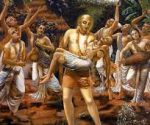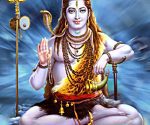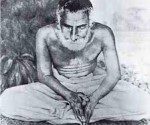The Last Limit of Bhakti
| In this beautiful cintamani lecture, Srila Gour Govinda Swami Maharaja, describes the mysterious and inconceivable tattva of Gaura-lila where two opposites are found in one container, union and separation. Furthermore, the Acarya presents how on rare occassions prema-vicittya-viraha is present in vraja-lila and how it is continuously present in Gaura-lila. This is the only different between Lord Sri Krsna and Sri Caitanya Mahaprabhu. |
| A Caitanya-caritamrta class adi-lila 10.114-118, recorded in the morning of January 7, 1993 in Bhubaneswar, India. |
| The Associates of Lord CaitanyaIn the adi-lila, Tenth Chapter of Sri Caitanya-caritamrta, Srila Kaviraja Goswami has given a description of the many expansions of the Caitanya tree, the branches and the sub-branches.
The whole chapter, chapter ten, is a very big chapter. Up till now, Kaviraja Goswami has said the seventy-seventh branch is Thakura Saranga Dasa. The seventy-eighth branch is Jagannatha Tirtha, the seventy-ninth branch is Sri Janakinatha and the eightieth branch is Gopal Acarya and the eighty-first branch is Vaninatha. Then comes eighty-second, eighty-third, eighty-fourth branches of the tree. the three brothers, Govinda, Madhava and Vasudeva. Then comes the eighty-fifth branch, Srila Krishnadas Kaviraja speaks about this: ramadasa abhirama—sakhya-premarasi solasangera kastha tuli’ ye karila vansi Ramadasa Abhirama was fully absorbed in the mellow of friendship. This Abhiram made a flute of a bamboo stick with sixteen knots. [Cc. Adi 10.116] prabhura ajnaya nityananda gaude calila tanra sange tina-jana prabhu-ajnaya aila By the order of Sri Caitanya Mahaprabhu, three devotees accompanied Lord Nityananda Prabhu when He returned to Bengal to preach. [Cc. Adi 10.117] ramadasa madhava ara vasudeva ghosa prabhu sange rahe govinda paiya santosa These three were Ramadasa Madhava Ghosa and Vasudeva Ghosa Govinda Ghosa, however, remained with Sri Caitanya Mahaprabhu at Jagannatha Puri and thus felt great satisfaction. [Cc. Adi 10.118] By the order of Sri Caitanya Mahaprabhu, Lord Nityananda Prabhu and three devotees then came to Gaudadesh, West Bengal to preach. They are Ramadasa, Madhava Ghosa and Vasudeva Ghosa. Govinda Ghosa remained with Sri Caitanya Mahaprabhu at Jagannatha Puri and he felt great satisfaction. Up to this description is there, then he speaks something more. This is a big chapter. One Difference Between Lord Krsna and Lord Caitanya So all of these devotees are very dear devotees of Sri Caitanya. They are very intimate. They know Gauranga and they know Krsna. It is mentioned in the Gaura-ganoddesa-dipika how most of them were in Krsna-lila, vraja-lila. Most of them were sakhis, manjaris and some were in sakhya-rasa, friendship, like this Abhirama mentioned here. They have all taken part in both Krsna-lila and Gaura-lila. They are the associates of Krsna and the associates of Gaura, because there is no difference between Gaura and Krsna. Is there any difference? No difference. Krsna is Gaura and Gaura is Krsna, so Krsna-lila is Gaura-lila and Gaura-lila is Krsna-lila. In tattva they are the same. But one difference is that in Gaura. In Gaura, two bodies are combined together: Radha and Krsna. That is the only difference, nothing else. radha — purna-sakti, krsna — purna-saktiman dui vastu bheda nai, sastra-paramana Sri Radha is the full power, and Lord Krsna is the possessor of full power. The two are not different, as evidenced by the revealed scriptures. [Cc. Adi 4.96] radha-krsna aiche sada eka-i svarupa lila-rasa asvadite dhare dui-rupa Thus Radha and Lord Krsna are one, yet They have taken two forms to enjoy the mellows of pastimes. [Cc. Adi 4.98] prema-bhakti sikhaite apane avatari radha-bhava-kanti dui angikara kari’ sri-krsna-caitanya-rupe kaila avatara ei ta’ pancama slokera artha paracara To promulgate prema-bhakti [devotional service in love of Godhead], Krsna appeared as Sri Krsna Caitanya with the mood and complexion of Sri Radha. Thus I have explained the meaning of the fifth verse. [Cc. Adi 4.99-100] sri-krsna-caitanya gosani vrajendra-kumara rasa-maya-murti krsna saksat srngara He made His appearance to taste that conjugal mellow and incidentally to broadcast all the rasas. [Cc. Adi 4.223] This is tattva. There is no difference between the energy and the energetic, sakti-saktiman abhinna. Therefore there is no difference between Radha and Krishna. Radha is purna-sakti and Krsna is purna-saktiman, so there is no difference, but lila-rasa asvadite dhare dui-rupa, to relish the mellow of the pastimes two bodies are there, Radha and Krsna, otherwise they are one. The Last Limit of Bhakti So in vraja-lila there are two bodies, Radha and Krsna, visaya and asraya. But in the form of Gauranga They are one. Radha and Krsna combined together. Krsna assuming the mood and complexion of Radharani appears and that is Gauranga, yes. This is tattva, and this is a very deep and confidential tattva. Narahari Sarkara has said: caitanya bhakti-naipunya krsnas tu bhagavan svayam tayo prakasa dekatra krsna-caitanya uccyate Follow the language? Caitanya bhakti-naipunya, krsnas tu bhagavan svayam. Caitanya is Krsna and Krsna is Caitanya, there is no difference. But in Caitanya one thing is added – that is bhakti-naipunya. When Krsna comes assuming the mood of a bhakta, He is Caitanya. But without the mood of a bhakta that is Krsna. So Caitanya means, caitanya bhakti-naipunya krsnas tu bhagavan svayam, tayo prakasa dekatra krsna-caitanya uccyate. Krsna is the Absolute Truth, advaya-jnana-tattva, the Supreme Truth, parama tattva. And so Caitanya is also advaya-tattva, the Supreme Truth, parama-tattva, but one addition is there, that is bhakti-naipunya, the last limit of bhakti – prema-bhakti. If prema-bhakti is added to Krsna, that is Caitanya. Therefore Sacinandana Gauranga is the Supreme Absolute Truth, parama-tattva – Bhagavan, but with bhakti-naipunya added. That is Gauranga. In the Gauranga form you will find two things combined together. What are those? Sambhoga – union and vipralambha – separation. These two things combined together, that is Gauranga. And that is bhakti-naipunya, the last limit of bhakti, that is prema-bhakti. Sadhana and sadhya – the means and the ends. So the sadhya, the end is prema and that is bhakti-naipunya. It means prema-bhakti. So bhakti-naipunya means prema-bhakti. If that prema-bhakti is added to Krsna, that is Gauranga, nothing else. And in that Gauranga form you will find these two opposites are placed together, sambhoga, union and vipralambha, separation. We say, virodhita – opposite things placed together. This you will only find in the combined form of Radha and Krsna. That is Gauranga. Otherwise you will never find it anywhere else, it is only in Gauranga. Vraja Lila Has Two Embankments In Vraja, will you find these two things combined? No, not possible at all, because in vraja-lila two bodies are there, Krsna and Radha. And in vraja-lila, the flow of that lila is like the flow of a river. As a river has two embankments, right embankment and left embankment similarly the flow of vraja-lila has two embankments; that is sambhoga and vipralambha. The sambhoga-tata and vipralambha-tata, [tata means embankment]. The embankment of union and the embankment of separation. There are two embankments. Understood? Try to understand. So on the embankment of union both Radha and Krsna relish the mellow of union. On the embankment of separation both Radha and Krsna relish the mellow of separation. It is mentioned in the Ujjvala-nilamani that on the embankment of separation the relishment of this mellow, viraha-rasa, is of four types: purva-raga, mana, prema-vaicittya and pravasa. These are specific words. Just hear it, when you will get to read or hear Ujjvala-nilamani you can see that Rupapada has given elaborate explanations. So four types of relishment are there, and similarly on the embankment of union there are also four types of relishment. That is samhksipa, sankirna, sampanya and samriddhimana. This Caitanya-caritamrta is the postgraduate study so everything will come up: Ujjvala-nilamani, Vidagdha-madhava, Bhakti-rasamrta-sindhu, all these books will come up. So samksipa, sankirna, sampanya and samriddhimana – these are found on the embankment of union, and they have connection with the other embankment, the embankment of separation. First comes samksipa. Samksipa is relished after the first type in viraha-tattva, that is purva-raga. First viraha and then milana or sambhoga. Samksipa is relished after purva-raga-viraha. Similarly, sankirna is relished after mana-viraha. Then sampanya is relished after prema-vaicittya-viraha. And samriddhimana is relished after pravasa-viraha. Understand? This is just to have an idea of the four types of relishment on each embankment. These two opposite things, sambhoga and vipralambha, union and separation are always required otherwise there will be no question of the flow of these transcendental loving conjugal pastimes. They are always there, and the two opposites are always required otherwise if these two were not there how will there be a flow? How will there be movement? You have two legs, a right leg and a left leg, and then you are moving. A bird has two wings, a right wing and a left wing then it can fly. Similarly, two embankments are there: sambhoga and vipralambha, so the lila will flow in Vraja. Another thing is there. On the embankment of sambhoga there is sukha, happiness. Union means happiness. On the embankment of vipralambha, viraha or separation there is accute pain – the pangs of separation. Intense heat, yes, intense heat is there and vilapa, crying is also there. These two opposites are eternally there in Vraja. They are not in one container, they are on two separate embankments. But in Navadvipa-lila or Gaura-lila these two opposites are contained in one pot: union and separation together. Gaura is the combination or union of Radha and Krsna, Who also at the same time accepts vipralambha-bhava; feeling the pangs of separation from Krsna. Two opposites are in one container. Two opposites. This is the tattva here. Visaya and asraya, the object of love and the abode of love. Krsna is visaya, the object of love and Radha is asraya the abode of love. In Vraja They are eternally visaya and asraya. Thus the flow of lila is going on, lila-prabha. But in Gaura, asraya and visaya are combined together. Two opposites: union and separation combined in one container, this is the tattva. Ekadi karana, two opposites together. It is avicintya – inconceivable. We cannot conceive of it. Prema Vaicittya in Vraja Lila But one question is there. In vraja-lila, vraja-vilasa, union and separation cannot be placed together, they are taking place separately, never together. But in Gaura-lila you will find they are together – two opposites are there. This is wonderful, very mysterious and inconceivable, but Rupapada says,”It is not a fact that in vraja-vilasa these two are never placed together. It is not a fact. It is there in vraja, but not always, and not everywhere. In some special cases for a fleeting moment, a very temporary period, it is there.” Rupapada has written like this, and such devotees they relish it. Rupa Goswami has mentioned this in the Vidagdha-madhava and the Lalit–madhava dramas. It is called prema-vaicittya. That means one feels separation in union. If one feels separation in union, that becomes prema-vaicittya, and you will find this prema-vaicittya in Vidagdha-madhava and Lalita-madhava. These two opposites are together there. Union is there and the feeling of separation is also there, for a very short moment. Sri Radhika and the Bumblebee I am giving one example from the Vidagdha-madhava. On the bank of the Yamuna, both Radha and Govinda are playing there. Then Vrnda Devi came with two lotuses. vrnda: (parikramya. nirajany ahrtya ca) pundarikaksa stokotphullam idam grhana lila-pundarikam. tathavatamsocitam kokanada-dvandvam Vrnda: (She walks and picks some lotus flowers) Lotus-eyed Krsna, please take this slightly-blossomed white lotus as a toy, and these two red lotuses as earrings. [Vidagdha-madhava, act 5, text 41a] That is the language of Rupapada’s Vidagdha-madhava. Read this book. Kokanada-dvandvam means two lotuses, dvandvama means a pair and kokanada means lotuses. So Vrnda Devi came with two lotuses in her hand to decorate Radharani as earrings. She gave them to Krsna. krsnah: (sa-harsam adaya) vrnde raktotpale radha-karnayor adhanena sriyam labhatam. (iti tatha krtva. sa-kautukam) hanta pundarika-kose cancariko vartate. Krsna: (Happily taking the lotuses) Vrnda, these two red lotuses will beautify Radha’s ears. (He does that. He then expresses surprise). Ah! There is a bumblebee in the whorl of this white lotus. [Vidagdha-madhava, act 5, text 41b] Krsna with a smiling face, took them with much pleasure. He was about to place the lotuses as earrings on Radharani when He noticed, pundarika-kose cancariko vartate, a black bumblebee was there in the whorl of the lotus. Radharani noticed the bumblebee. Krsna said: krsnah: (sphutam vihasya) karnottamsita-rakta-pankaja-juso bhrngi-pater jhankriya bhrantenadya drg-ancalena dadhati bhrngavali-vibhramam trasandolita-dor-latanta-vicalac-cuda jhanat-karini radhe vyakulatam gatapi bhavati modam mamadhyasyati Krsna: (Openingly laughing) “Attracted by Your lotus lotus flower earrings, the best of the bumblebees hoovers around You, followed by Your restless sidelong glances, like a swarm of bumblebees. With bracelets tinkling, You wave Your creeper-like arms to chase him away. O Radharani, (I must say that) Your fear of this bee brings Me great delight.” [Vidagdha-madhava, act 5, text 43b] radhika: (sa-trasam celancalam udancayanti) katham ajjabi na caladi dhittho Radhika: (With fear, She moves the edge of Her sari) “Why will this insolent fellow not go away?” [Vidagdha-madhava, act 5, text 44a] Then Radharani said,”Hey! Bumblebee, get out!” Then that bumblebee coming out of the lotus, sees Radharani’s lotus face then thinks the face of Radharani to be another lotus and flew there. Radharani then says while moving Her hand, “Hey get out! Get out!” Then the bumblebee thinks the palm of Radharani’s hand is another lotus and flys towards Her lotus hand. Radharani says, “This mad bumblebee, shameless debauchee is not going away. Get out! Get out!” With the corner of Her sari She tries to drive him out. And Radharani is also frightened that the bumblebee is not going away. Krsna says: krsnah: madhuraksi mudhatha sambhramena ksipa celancalam anjasa na bhuyah pibatu sravanotpaladgatam te madhupo ‘yam madhu-mangalam krsangi Krsna: “O sweet girl, don’t uselessly wave Your sari. O slender girl, let the bumblebee drink the pleasant honey of the lotus flowers in Your ears.” [Vidagdha-madhava, act 5, text 44b] {The word madhumangala in the last line is the name of Lord Krsna’s friend. interpreted in that way, the verse becomes: “O sweet girl, don’t uselessly wave Your sari. O slender girl, let the bumblebee sting Madhumangala when he approaches the lotus flowers in Your ears.”} madhumangalah: bho va-assa kisa bamhanam mam mahubena viba-esi (iti dandena bhramaram tadayati) Madhumangala: “O friend, why do You make this bee sting me, a brahmana? (He drives the bee away with the stick).” [Vidagdha-madhava, act 5, text 45a] radhika: (sa-slagham) ajja pi-ankaro mamasi samvuttah Radhika: (Praising) “O noble sir, you are very kind to Me.” [Vidagdha-madhava, act 5, text 45b] At that time, Madhumangala with a stick in his hand drove out that bumblebee, some far distance away. Then returning he said: madhumangalah: kaham mahusu-ano takkala jevva tirohido jam kudo bi na lakkhi-adi Madhumangala: “How did that bee disappear? I don’t see him anywhere?” [Vidagdha-madhava, act 5, text 45c] {If the word mahusu-ano is interpreted to mean “Lord Krsna, the killer of the Madhu demon,” the meaning of this statement becomes: “How did Krsna disappear? I don’t see Him anywhere.”} So Madhumangala came back he said, mahusu-ano takkala jevva tirohido jam kudo bi na lakkhi-adi. This is specific language. Unless you understand the language you cannot relish it. Mahusu-ano has two meanings. One meaning of mahusu-ano is bumblebee. Another meaning is Krsna. So Madhumangala meant to say the meaning of mahusu-ano as a bumblebee. But Radharani understood his words to mean Krsna. Do you follow me? Follow my language? Try to. This is a wonderful thing. Do you understand? Otherwise you cannot relish it. You can’t relish it unless you understand this language. This is very specific language. Mahusu-ano takkala jevva tirohido, the bumblebee has disappeared. Madhumangala points out that the bumblebee has gone but what did Radharani understand? She understood that Krsna has gone! Do you understand me? Mahusu-ano means Krsna also. “Krsna has gone!” As soon as Radharani heard this She said: radhika: (sa-vyamoham) haddhi haddhi. kahim gado mahumahano. (iti sanskrtena) samajani davad vitrastanam kim arta-ravo giram mayi kim abhavad vaigunyam va nirakusam iksitam vyaraci nibhrtam, kim va hutih kayacid abhistaya yad iha sahasa mam atyaksid vane vanajeksanah (krsnah samjnaya sarvan nivarya smitam karoti). Radhika: (Bewildered) “Alas! Alas! Where has Krsna gone? (In sanskrit) Where is Lord Krsna, Who responded to the pained cries of the gopas, frightened of the forest fire? Have I offended or avoided Him? Is it because some desired gopi called Him to a secluded place that lotus-eyed Krsna has so quickly abandoned Me in this forest?” (With a gesture, Krsna wards off everyone. He smiles) [Vidagdha-madhava, act 5, text 45d] As soon as Radharani heard what Madhumangala said, She said: haddhi haddhi. Kahim gado mahumahano. Radharani said like that. This is drama. “Oh” — haddhi haddhi. Kahim gado mahumahano. “Alas! Alas! Where has Madhusudana Krsna gone. Oh Alas!” Krsna is standing there but Radharani has now started crying, “Oh where has Madhusudana gone?” Yad iha sahasa mam atyaksid vane vanajeksanah, this is the language of Radharani. “Why that lotus-eyed Krsna left Me alone here in this forest of Vrndavana on the bank of the Yamuna, why does He do so? Alas!” Then She starts weeping and crying, but Krsna is there. This is a very wonderful thing, prema-vaicittya-viraha. The lover and the beloved are both there but feeling the pangs of separation. This is prema-vaicittya. Then Krsna says, “samjnaya sarvan nivarya smitam karoti.” Krsna drove them all out, Vrnda Devi, Madhumangala… He smiled, just smiled and said, “Radhe, aho.” This is very wonderful, prema-vaicittya viraha. This is in Vidagdha-madhava. Many instances are there of prema-vaicittya-viraha. In Lalita-madhava you will find candravali-milana, and also nava-vrndavana-sangamah and purna manoratha. So many things are there, Rupapada has written about this prema-vaicittya-viraha. That means, though Krsna and Radha are there together, They are feeling pangs of separation for a short time, on very special occasions. Not always, no everywhere. Prema-vaicittya cannot be there in Vraja. But in Gaura-lila it is always there, two opposites are placed in one container. That is Gaura, vipralambha and sambhoga together. Gaura-lila is a very mysterious lila, tattva. You cannot find anywhere else these two opposites together except in Gaura-lila. Thank you. After Class Darsan Such wonderful lilas, very mysterious and inconceivable. This Gaura–tattva is very deep, confidential tattva, yes. It is the highest, the highest, and very confidential and very deep tattva. Therefore, it is said it is postgraduate study. The students of that post-graduate class, they can understand. Otherwise other students who are not post-graduate cannot understand it. So we have started this course in this Caitanya University. We have started the course, two lectures weekly Thursday and Friday. So anyone who comes here should just hear, just hear. They cannot understand if he is not a student of that post-graduate class. Anyhow, sitting just let it touch your ear, that is beneficial. Let it touch the ear. Time will come you can understand, and you should cry for that, kabe ha’be bolo se-dina amar. This very nice song is there by Bhaktivinoda Thakura. “When will that day come in my life when I can understand this, with such ecstasy I can roll, I can dance, I can relish.” Like this. Yes. You should feel like that, cry, cry. “When, when will that day will come? When will that auspicious day will come in my life so I can relish it, I can understand it, I can become ecstatic, dance and roll and shed tears and be overwhelmed with that bhava, drowned, drowned, intoxicated.” Therefore we speak these things, just to put you in such a condition of crying. Hankering, yes. |




